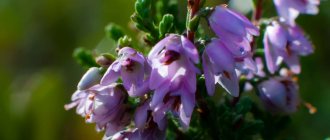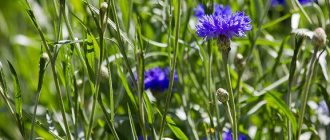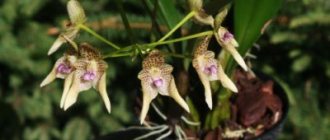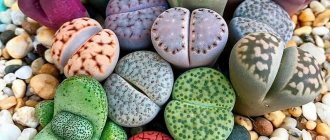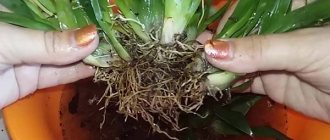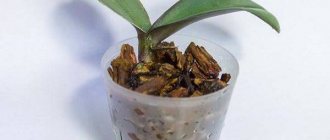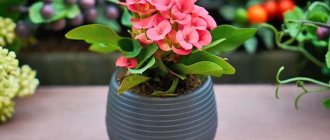Phalaenopsis Mini: variety varieties
Pink girl
- Phalaenopsis Jiaho's Pink Girl and Phalaenopsis Wenlong Pink Girl;
- This pink girl may also have a scent. Or maybe without it.
Pink Girl (Jiaho's Pink Girl).
Mark fragrant
Phalaenopsis Mini Mark:
- Phalaenopsis Mini Mark is the most famous. This is a hybrid of created miniature phalaenopsis from the novelti group;
- Grows up to 10-15 cm in height . And you need a miniature pot - 6-9 cm;
- The leaves are the color of malachite and can be 10-15 cm long;
- The flowers are small, only 3-4 cm. There are orange dots on the white petals. It is also fragrant;
- On other Mini Stamps there are inclusions of other colors (yellow or pink). And the lip is orange-brown.
The mark is fragrant.
Variety Multiflora
Multiflora (abundantly flowering) is the name of orchids with many small flowers (up to 6 cm) . They may be medium in size. Often, multiflora flower stalks grow continuously throughout the flowering cycle, while they branch, creating the opportunity for the growth of even more buds.
Those. the presence of both the words Multiflora and Mini in the name of the variety can be understood as a small plant (mini) with many small flowers (multiflora).
Multiflora.
Philadelphia
- Phalaenopsis Philadelphia. Hybrid (Phalaenopsis Schiller and Phalaenopsis Stewart);
- And originally from the Philippines;
- Occurs in natural environments;
- The silvery-green leaves seem to be painted with marble;
- The flowers are of different colors, but mostly pink-violet.
Philadelphia.
Hummingbird
- The miniature orchid is notable for its star-shaped flower;
- And more like a hummingbird bird;
- Small in size and original in appearance;
- The peduncle is also small. But there are several flowers on it.
Phalaenopsis hummingbird “at the withers” reaches 40 cm.
Pink orchids: varieties and their descriptions
Orchids are considered capricious houseplants.
This rule applies to all types. Although some varieties - especially those that bloom with pink buds - are characterized by easier care. Most often, such varieties are demanding on the water regime. Plants exhibit excellent growth when the room has high humidity and a stable temperature. When properly maintained, pink orchids will bloom most of the year. When growing these types of orchids, it is worth considering the fact that they grow in the wild in the tropical zone on the trunks and roots of trees. Therefore, plants form an elastic root system, which gives them the opportunity to receive a stable flow of substances necessary for life and development. Being epiphytes, these flowers in an apartment need to create certain conditions that are optimal for their life.
Plants have the following general description:
- small sizes;
- small oblong oval-shaped leaves. The leaf plate reaches 8 cm in width and 15 cm in length;
- The color of the leaf blade is dark green. Some varieties have a red tint on the back of the leaf.
A distinctive feature of such orchids is that they all form buds consisting of pink petals. Externally, the buds resemble butterflies.
The peduncle usually develops a dark purple color. It is elongated by 25–30 cm. On average, about 15 flowers of pink or pink-white color are formed on it. They form neat rosettes. The buds sprout gradually. Flowers can reach 3 cm in diameter.
Video “Miracle remedies for orchids”
In this video, the expert will talk about garlic infusion, banana skins, succinic acid and hydrogen peroxide for orchids.
Popular representatives
Orchids that bloom pink flowers are featured in each group of these tropical beauties. Let's take a closer look at those varieties that are most often grown in apartment conditions.
Wanda Sandera
This variety is most popular among residents of the Philippines. Today, Wanda Sandera is on the verge of extinction. Therefore, the export of orchids outside the country is prohibited. Only hybrid varieties of this species can be purchased in flower shops.
Vanda sandera is considered a tall plant. With proper care, the flower can grow more than 1 m in height. The orchid is characterized by a very powerful root system. Thanks to this, the plant is able to absorb from the air all the substances necessary for growth and development.
This variety produces very beautiful belt-like petals. They have a forked tip. On average, one peduncle produces about 10 buds.
Phalaenopsis Pink
This representative of pink orchids produces buds that look like beautiful butterflies. The plants are distinguished by small, elongated, oval-shaped leaves. About 10–15 buds are formed on the peduncle, which are often colored white and pink. The buds can be 3 cm in diameter. Phalaenopsis Pink is the most common indoor flower.
Dendrobium bihump
In nature, this variety grows in northeastern Australia. The orchid prefers to grow on rocks or on small trees. It is a sympodial lithophyte or epiphyte that can grow up to 122 cm in height. Large specimens are most common. Plants are capable of forming pseudobulbs.
The upper part of the shoot is usually covered with leaves. The leaf blade can be lance-shaped or oblong. The leaves have a purple or reddish tint. The death of stems is observed at the base. Therefore, in this place, under certain conditions, children can be formed.
The annual growth is 1–4 peduncles. They are formed in nodes located at the apex of the pseudobulb. Peduncles can be hanging, curved or horizontal. The buds form evenly along the top of the flower stem.
Dendrobium bihumpy forms large beautiful flowers, the diameter of which can reach 7 cm. The petals are quite wide and overlap each other. The middle lobe of the lip is often longer than the other petals and pointed.
The flowering period of this variety lasts from July and ends in January. Peak flowering occurs in autumn.
Cattleya Percival
As difficult as it may be to guess from the name, this species belongs to the species of unifoliate Cattleyas. The plant forms pseudobulbs, which can reach 15 cm in length. The peduncle usually grows 25 cm.
Cattleya Percivale produces pink-purple buds. A distinctive feature is the formation of a crimson lip with yellow-orange spots and a light edging along the edge. One inflorescence often produces 2–4 buds with a diameter of 10–12 cm. The flowering period occurs in mid-winter.
Miltonia
This flower is a sympodial epiphyte. The plant forms aerial roots and pseudobulbs. Indoor representatives are characterized by the elongated shape of the leaves, which are colored yellow or gray.
Pseudobulbs form several panicle-like stems. Their color can be white, yellow or pink. The petals have a beautiful pattern that resembles the wings of tropical butterflies.
In total, the genus Miltonia has about 20 different species.
The most popular varieties of pink orchids have been described above, which most often can be grown at home without any problems.
A lyrical digression, or a little about the history of orchids
So, you received an orchid as a gift... Don't forget to ask what its name is. If there is no sign (tag, memo) with its name.
And you begin to get acquainted with the gift. This acquaintance will open up a whole world of orchids.
They are affectionately called orchids. Phalaenopsis is a little more difficult to pronounce. The history of their appearance and development is amazing. Information about their existence takes us back three thousand years. Even then they were a subject of admiration. Some of them no longer exist. But many new ones have appeared.
And what do we know about them:
- Georg Rumph was the first to talk about the amazing flowers he saw on the Moluccas. This was in the seventeenth century;
- In the book “Species of Plants”, Carl Leinaeus called these flowers the delightful epidendrum;
- Phalaenopsis is from Karl Blume. During his expedition, he confused them with moths. And they began to compare them to moths;
- And this was not the last name. You will also find the following names: Doritis;
- Kingiella;
- Grafia;
- Lesliea;
- Sunadena;
- And not only. After all, there are more than 70 species of them;
- And many varieties do not have a permanent name in Russian.
Under natural conditions, they are well known to residents of Southeast Asia. Places are warm and humid. In the mountains and plains. The southern regions of China are even considered their homeland.
But they don’t grow on the ground. They are epiphytes - plants that grow on other plants. They are called phorophytes.
The same Karl Lineus, in 1753, laid the foundation for the systematization of orchid species.
And these days, the exact names are available to specialists. And also, the so-called orchidists. For lovers and beginners interested in these plants, a different list is applicable.
It is also called consumer classification. According to it, phalaenopsis varieties are divided according to the type of flowering. Let's get to know them:
- Standard: Flowers are large (up to 12 cm). They grow in the upper part of long peduncles;
- After flowering, the apical bud dies.
- Small flowers (3-8 cm) are placed on a peduncle growing from the upper bud;
Phalaenopsis Pylo's Novelty.
- Multiflora: Many flowers (no more than 6 cm) on one peduncle, which often branches;
- The shape of their flowers is similar to the standard ones.
But sellers and distributors of these colors use commercial classification. They are interested not only in the size of the flower, but also in the size of the entire plant. Larger leaf sizes, more colors - and it costs more. Although the size of the flowers is the same. Like selling a mimosa branch before March 8th. The larger, the more expensive.
The most delicate pink phalaenopsis orchids: photos and names of varieties
Orchids are one of the oldest plants on our planet .
Due to the fact that they can adapt to different natural conditions, they can be found in different parts of the world. The most unpretentious orchid, phalaenopsis, is most often grown indoors. If you follow simple rules, it will delight you with its flowering for months.
In this article we will look at the names and photos of varieties of pink phalaenopsis.
Pink Phalaenopsis Rosea
The Phalaenopsis genus includes about 50 plant species. All of them belong to the Orchidaceae or Orchidaceae family. They are distinguished by wide leaves and butterfly-like flowers, the petals of which are complex and painted in pastel colors.
Pink phalaenopsis (Phalaenopsis rosea) is one of the smallest subspecies, an epiphyte . The plant's favorite habitat is river banks.
The rosette consists of 2-5 oblong leaves, up to 20 cm long and about 5 cm wide. On a short peduncle about 30 cm long there are about 15-20 small white-pink flowers , which bloom one after another.
The inflorescence can be simple or branched, arched. The size of the flowers in diameter is 25 mm.
Flower appearance:
- sepals are pink in color with vertical white stripes, oblong;
- the lip is small with three lobes, colored from pink to dark purple.
Phalaenopsis can delight you with its flowering at any time of the year. “Children” regularly appear on faded flower stalks, which can be used to propagate the plant.
Description
What is characteristic of mini orchids:
- The shape of the flowers is the same as the standard ones. Just a smaller size;
- And according to the type of flowering - both standard and novelty. But more than that, it’s multifleur. By the way the vast majority of multiflora are mini orchids;
- Their leaves cannot be called miniature. But there are many flowers on branched peduncles;
- As a rule, they do not grow more than 20 cm. True, hybrids of standard orchids can grow up to 30 cm.
Why do they want to buy a mini:
- Their size allows you to find a place for them even in a small apartment or office;
- Small forms allow fans to fantasize and experiment, creating amazing compositions;
- Caring for them is not as difficult as large-sized ones;
- And they cost less. Especially during sales.
Note:
- When purchasing, carefully inspect the plant. They are usually sold in transparent pots. It’s easier to watch them this way;
- The roots of healthy plants are juicy, elastic and green. And not just one or two roots, but more;
- And leaves. Fresh. Without damage, any spots or wrinkles;
- When replanting, cut off and process slightly dried roots.
Carefully inspect the plant before purchasing.
Existence in nature
- Phalaenopsis Minis are hybrids;
- Moreover, many are related to many well-known natural ones. And hybrid;
- They are designed for home use.
External characteristics
Height
- They can grow up to 20 cm . And not just in height;
- These can also be branched peduncles with many flowers hanging down.
Number of leaves
- Mature plants attract attention with beautiful leaves. Their colors can be varied (dark green, marble, etc.);
- They can grow up to 15-20 cm;
- But the number of such leaves is limited. Only 4-6. But this is enough to nourish beautiful flowers.
Maximum peduncle length
- It is the peduncle that determines the height of the plant;
- Along with flowers;
- For a mini, 15-20 cm seems to be the limit.
Diameter, flower shape
- Flower sizes for mini orchids are average;
- And the shape is typical - reminiscent of a butterfly.
Colors
- The posted photos give an idea of the colors of some mini-orchids;
- Their diversity is amazing.
Some color options for Phalaenopsis Mini.
Features of flowering
Duration
Having received this amazing flower as a gift (or bought it in a store), you will want to contemplate it longer. If you follow all the care recommendations, flowering can last up to six months. After all, don’t forget about the time of year.
Start at home
- They sell and give orchids and flowers. This is not an apple tree, where you have to wait at least 2 years for the first fruits;
- Depending on the quality of care and the condition of the plant itself in our conditions, spring is the most favorable time for flowering. According to some experts;
- Here is the opinion of others. Any time is suitable. But more often from November to March.
Is it possible to do it again?
- They can bloom again;
- Provide conditions. And not only will you see your orchids blooming again.
Pink orchids: varieties and their descriptions
Pink orchids are considered classic representatives of the world of exotic plants. Most flower growers consider the traditional coloring of capricious beauties from the Orchid family. Despite the fact that phalaenopsis are considered very capricious and demanding plants, even a novice gardener can cope with their cultivation. It is only important to follow all care recommendations, monitor the condition of your pets and listen to the advice of knowledgeable people.
The most popular varieties
There are several popular varieties.
- The most famous variety is the pink Phalaenopsis (Rosea), whose small, delicate flowers resemble butterflies. This plant is considered one of the smallest in its family: the height of its peduncle usually reaches 30 cm, the length of the leaves is about 20 cm. The color of the flowers is soft pink, diluted with narrow white stripes. The average diameter of the blooming flowers is 2.3–2.5 cm. Pink Rosea orchids are especially valued by plant growers for their long flowering, during which numerous buds open one after another. Small and very elegant pale pink striped flowers, contrasting with a rosette of dark green leaves, give this plant a special decorative effect.
- The “Pink Dragon” orchid is a spectacular hybrid variety of phalaenopsis, distinguished by its unusual mosaic coloring. The petals of the flowers of this plant have a very light pale pink color, against which hundreds of microscopic dots of purple-lilac color are scattered. Another characteristic feature of this variety of orchids is the convex golden-yellow core, shaped like a bow.
Landing
Priming
- soil for planting in a specialized store. Experienced flower growers prepare their own;
- Sold in transparent containers with sphagnum moss;
- Tree bark forms the basis of the soil. For mini orchids they should be small - about one centimeter;
- You soak them in water for several days. And dry;
- You can also make a mixture of pine bark and dry moss. Add a few small pieces of charcoal. If the humidity in the room is insufficient.
It is better to buy soil for orchids in a store.
Optimal capacity
- The container must be transparent. And mini orchids do not need their larger sizes;
- Where to get? In a specialized store, just tell them that you need a mini phalenpsis container. The offer will be mandatory;
- There is also a universal transparent plastic bottle. They left the soda after. But only with numerous holes for good ventilation.
Peculiarities
- Repot orchids on a bed of moss once a year;
- And do it in the spring. It is at this time that a new leaf appears from its growth point. And also necessarily before the formation of the peduncle;
- Use small pieces of bark (if replanting in bark soil);
- She doesn't need large pots;
- When replanting, to remove old soil or moss, it is enough to immerse it in water for a few minutes.
Features of care
Optimal conditions of detention
Connoisseurs and specialists know. And newcomers remember:
- Warmth and humidity. Like in Southeast Asia;
- Just don't overdo it with moisture.
Looking for a bright place where the sun's rays do not reach. If there is, the eastern sides are good.
If you have the opportunity, equip additional lighting with lamps . Without such lighting, you may not wait for flowering.
Orchids respond well to additional lighting.
Consider the main feature of care. You must select the soil for growth:
- This is often not pure pine bark for standard sizes;
- Form a cushion of sphagnum moss;
- Many people settle on a mixture of these components.
Advice! You can provide high humidity with a humidifier or spray bottle. And even placing a damp towel on heating radiators.
These Southern Asians are picky about temperature:
- They feel great in the range from 18 to 25 degrees. Even up to 30. At higher temperatures, trouble begins;
- In winter you should provide them with 15-20 degrees. And avoid sudden temperature fluctuations.
After purchasing in store
Home care after the store is as follows:
- You can replant a mini orchid immediately after purchasing it in a store (blooming will most likely be lost);
- It is pleasant and possible to admire a gifted flowering plant for a long time. If you know the rules of care;
- But this is dangerous for him in the absence of such knowledge.
Flowering time and dormant period at home
The dormant period for mini orchids appeared in our not warm places. So they begin to delight with flowers in the spring. Or since the fall.
Watering and fertilizing
The choice of watering method depends on the phalaenopsis soil:
- If the soil consists of a sphagnum moss pad: Water with less water. But more often;
- Spray daily morning and evening. And spoon it on. Maybe a tea room;
- Dives and spills are not suitable;
- Feeding also has its own nuances: With intensive growth - after 10-15 days;
- During the rest period - once a month;
- Some even advise against doing them during these periods;
- The best way is by leaf spraying.
- Water with warm water (30-40 degrees) as if from a shower;
Do not forget! Make sure that there is no stagnation of water in the pot so that the roots do not dry out. Use special coconut fibers. Wipe the leaves thoroughly and gently after watering.
How to stimulate flowering?
- Impeccably follow the recommendations for creating and maintaining a favorable regime for the plant;
- You can extend the flowering time by reducing watering. And placing it for a short period in places where it is a little cooler.
Pruning after flowering
- This is an essential element of plant care . Prune after flowering (except when cutting for a gift);
- Select a well-developed bud on the peduncle. A little higher than it and cut it off;
- And you wait 2-3 months for new flowering, taking good care of the plants.
Trimming diagram.
Prevention of diseases and pests
The most effective prevention of diseases and pests is, of course, proper care:
- Provide adequate lighting. Both in summer and winter. It is difficult to do without additional lighting;
- You can observe the recommended temperature and humidity using installed devices. And not only observe, but also observe;
- Water and feed carefully;
By the way! Many fans advise using garlic infusion for watering. Supports immunity.
- Check your pets regularly. Respond immediately to signs of disease and pests. And there are enough of them for these beautiful plants.
Description of pink orchid
The pink orchid is a tropical plant that lives on the roots and trunks of trees. Because in the tropics the climate is invariably humid and warm, then the same indicators must be maintained at home when growing phalaenopsis.
Description of the variety
Pink orchid flowers, similar to mother-of-pearl butterflies, are the main unique feature of this representative of phalaenopsis. On a long peduncle of dark purple color up to 25-30 cm long, up to fifteen pale pink flowers grow, connected into rosettes. The flowers of the pink epiphyte reach 3 cm in diameter. The color of the central part of the flower, called the anther, is much brighter than the petals.
Pink phalaenopsis orchids are one of the smallest species, with oblong dark green oval-shaped leaves, the length and width of which reach 15 and 8 cm, respectively. According to the description, the height of the entire plant reaches 45-55 cm. Often the plant has one or two peduncles.
Pink Dragon and Viola desiderio are also pink. Viola desiderio is distinguished by large multicolored flowers, 8 cm in diameter. The pink dragon is a hybrid species.
Growing
Pink phalaenopsis is great for growing at home and prefers placement on windows with wide sills facing east and west.
As is the case with many other Orchid species, it is important to take into account that in this family of plants the vital process of photosynthesis is also carried out in the tissues of the roots, so they need access to a light resource. This can be achieved by growing the flower in a transparent plastic pot.
In the evening, it is no less important to take care of fluorescent lighting, because... An orchid needs 12 hours of daylight for normal growth and development.
Landing
Often, vegetative propagation of pink epiphyte occurs due to offspring grown on the flower itself. After planting the children, flowering should be expected no earlier than a year later.
The soil in the pot must be enriched with drainage that has a beneficial effect on growth: pieces of tree bark, coals, finely crushed shells and sphagnum moss.
Temperature and light
Care implies an optimal temperature regime for the variety in winter, which is up to 20°C, while in summer the permissible temperature should not exceed 35°C. High air humidity and relatively stable temperature conditions are suitable for pink epiphyte.
Phalaenopsis are light-loving plants, so a place that will provide trouble-free passage of light is suitable for them, but if there is too much sunlight, the plant must be moved to a more shaded place, because the orchid may get a burn on the flower or leaves, from which it will be difficult to recover.
Watering
Pink phalaenopsis orchids prefer moderate watering. In warm months, plants moisten the soil as it dries once a week; in cold months, only a few times a month. It is important to prevent flooding or, conversely, excessive dryness of the substrate. For irrigation you need settled water kept at room temperature. Also, to maintain air humidity, it is necessary to place pebbles filled with water in the tray of the pot.
Feeding
The procedure for saturating the soil with complex fertilizer is usually carried out once every 2 weeks. Excessive amounts of it can inhibit flowering and cause mechanical damage to leaf tissue. An unfavorable concentration of mineral and organic fertilizers provokes inhibition of vital and metabolic processes in the plant, so you need to wash the substrate under hot water approximately once a week. The roots of this species are capricious, so they need to be constantly monitored; they should be consistently white or light yellow in color.
Diseases and pests
With controlled care, the plant rarely gets sick and is almost immune to damage by dangerous parasites. Still, there are common problems: root rot is common, and flowers are prone to damage from mealyworms, red mites, aphids, spiders, snails, whiteflies, thrips, woodlice, centipedes, etc.
- When the scale parasite appears, the leaves of the epiphyte become sticky and covered with dark spots. The pest sucks the juice from the plant, the composition of which provides vital activity to the entire body. The spots appear after the attack of the scale insect is followed by an attack of sooty fungus.
- Mealybugs can cause massive yellowing and leaf drop.
- The whitefly is a small butterfly, white in color. The butterfly itself and its yellow larvae feed on the sap of the orchid, as a result of which the plant noticeably weakens and begins to wither.
- Thrips also attack leaves, pale pink flowers and roots. Green or yellow larvae actively destroy the internal tissue of the leaves, so spots appear on them and, as a result, these organs die and fall off. Obvious traces of the presence of thrips are a silver film and a large number of small black inclusions.
Prevention
Preventative measures during care and cultivation are as follows:
- maintaining a stable level of temperature and humidity of air and soil;
- periodic inspections of the condition of the plant;
- regulating the lighting supplied to the plant;
- if necessary, by using chemicals (with preliminary study of the instructions);
- by transplanting into a new substrate when affected by certain types of pests.
Growing problems
How to revive a plant without roots?
With significant root loss:
- Place expanded clay on the bottom of a transparent pot for drainage. And on top is a substrate of bark and moss;
- Place the plant in this mixture;
- Place in a warm and well-lit place;
- Maintain humidity;
- Spray daily;
- And watch.
Such techniques can restore the roots.
Activation of root growth
Analyze. Maybe you haven't created the necessary conditions for the plant.
Reproduction
How often do they give babies?
- Babies appear on flower stalks. Healthy plants also produce good children;
- A leaf grows from a bud. And a little later, aerial roots;
- Only with their presence children are sent away.
Important! They do not appear so willingly or often. You can stimulate their appearance by cutting off the peduncle. And apply cytokine paste to the scaled kidney.
Baby phalaenopsis on a peduncle.
Methods
It is known that the vegetative method: seeds, division, apical cuttings.
You can propagate phalaenopsis yourself:
- And they do this by separating new side shoots. If they have grown to 5-6 centimeters. They are called children;
- Can be transplanted directly into prepared containers (pots). Cut plastic bottles are often used. With numerous holes;
- You can place them in special greenhouses with wet sphagnum moss. If they exist.
Remember! It is necessary to cut with a disinfected instrument (knife, scalpel, scissors).
Transplant from moss - carry out for phalaenopsis purchased in stores:
- You can implement it immediately;
- Or you can wait. Until it blooms;
- At the same time, ensure proper care.
External characteristics of a dwarf plant
It is worth describing in more detail the main features of the dwarf orchid. This will allow you to understand why it is classified as a Phalaenopsis, and what its characteristic features are:
- The leaves are green, usually up to 35 cm, and may have a pointed or blunt part at the end. They are no more than 8 cm wide and completely cover the stem. Depending on the variety, there may be up to five leaves.
- The root system is well developed. With these roots, the flower receives nutrients both from the soil and from the soil. Some parts of the roots are not in the ground.
- The peduncle rarely exceeds 50 cm. One plant can have up to 4 peduncles at the same time.
- The flowers have different shades. It all depends on the variety. Their size is about 3.5 cm. At the same time, there are from 5 to 15 buds on one peduncle. They open almost simultaneously.
- The stem is dense, but small, completely hidden behind the leaves.
